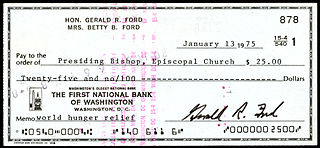
A banknote—also called a bill, paper money, or simply a note—is a type of negotiable promissory note, made by a bank or other licensed authority, payable to the bearer on demand. Banknotes were originally issued by commercial banks, which were legally required to redeem the notes for legal tender when presented to the chief cashier of the originating bank. These commercial banknotes only traded at face value in the market served by the issuing bank. Commercial banknotes have primarily been replaced by national banknotes issued by central banks or monetary authorities.

In finance, a loan is the transfer of money by one party to another with an agreement to pay it back. The recipient, or borrower, incurs a debt and is usually required to pay interest for the use of the money.
The money market is a component of the economy that provides short-term funds. The money market deals in short-term loans, generally for a period of a year or less.

A financial transaction is an agreement, or communication, between a buyer and seller to exchange goods, services, or assets for payment. Any transaction involves a change in the status of the finances of two or more businesses or individuals. A financial transaction always involves one or more financial asset, most commonly money or another valuable item such as gold or silver.

A negotiable instrument is a document guaranteeing the payment of a specific amount of money, either on demand, or at a set time, whose payer is usually named on the document. More specifically, it is a document contemplated by or consisting of a contract, which promises the payment of money without condition, which may be paid either on demand or at a future date. The term has different meanings depending on its use in the application of different laws and depending on countries and contexts. The word "negotiable" refers to transferable and "instrument" refers to a document giving legal effect by the virtue of the law.

A cheque or check ; is a document that orders a bank, building society to pay a specific amount of money from a person's account to the person in whose name the cheque has been issued. The person writing the cheque, known as the drawer, has a transaction banking account where the money is held. The drawer writes various details including the monetary amount, date, and a payee on the cheque, and signs it, ordering their bank, known as the drawee, to pay the amount of money stated to the payee.

Security market is a component of the wider financial market where securities can be bought and sold between subjects of the economy, on the basis of demand and supply. Security markets encompasses stock markets, bond markets and derivatives markets where prices can be determined and participants both professional and non professional can meet.
A bearer instrument is a document that entitles the holder of the document to rights of ownership or title to the underlying property. In the case of shares or bonds, they are called bearer certificates. Unlike normal registered instruments, no record is kept of who owns bearer instruments or of transactions involving transfer of ownership, enabling the owner, as well as a purchaser, to deal with the property anonymously. Whoever physically holds the bearer document is assumed to be the owner of the property, and the rights arising therefrom, such as dividends.
Secured transactions in the United States are an important part of the law and economy of the country. By enabling lenders to take a security interest in collateral, the law of secured transactions provides lenders with assurance of legal relief in case of default by the borrower. The availability of such remedies encourages lenders to lend capital at lower interest rates, which in turn facilitates the free flow of credit and stimulates economic growth.
In trade finance, forfaiting is a service providing medium-term financial support for export/import of capital goods. The third party providing the support is termed the forfaiter. The forfaiter provides medium-term finance to, and will commonly also take on certain risks from, the importer; and takes on all risk from the exporter, in return for a margin. Payment may be by negotiable instrument, enabling the forfaiter to lay off some risks. Like factoring, forfaiting involves sale of financial assets from the seller's receivables. Key differences are that forfait supports the buyer (importer) as well as the seller (exporter), and is available only for export/import transactions and in relation to capital goods. The word forfaiting is derived from the French word forfait, meaning to relinquish the right.
In banking, a post-dated cheque is a cheque written by the drawer (payer) for a date in the future.
In the United States, a mortgage note is a promissory note secured by a specified mortgage loan.

A substitute check is a negotiable instrument that is a digital reproduction of an original paper check. As a negotiable payment instrument in the United States, a substitute check maintains the status of a "legal check" in lieu of the original paper check, as authorized by the Check Clearing for the 21st Century Act. Instead of presenting the original paper checks, financial institutions and payment-processing centers transmit data from substitute checks electronically through the settlement process, through the United States Federal Reserve System, or by clearing the deposits on the basis of private agreements between member financial institutions. Financial institutions that process substitute checks in accordance with such private agreements are typically members of a clearinghouse that operates under the Uniform Commercial Code (UCC).

Canadian contract law is composed of two parallel systems: a common law framework outside Québec and a civil law framework within Québec. Outside Québec, Canadian contract law is derived from English contract law, though it has developed distinctly since Canadian Confederation in 1867. While Québecois contract law was originally derived from that which existed in France at the time of Québec's annexation into the British Empire, it was overhauled and codified first in the Civil Code of Lower Canada and later in the current Civil Code of Quebec, which codifies most elements of contract law as part of its provisions on the broader law of obligations. Individual common law provinces have codified certain contractual rules in a Sale of Goods Act, resembling equivalent statutes elsewhere in the Commonwealth. As most aspects of contract law in Canada are the subject of provincial jurisdiction under the Canadian Constitution, contract law may differ even between the country's common law provinces and territories. Conversely; as the law regarding bills of exchange and promissory notes, trade and commerce, maritime law, and banking among other related areas is governed by federal law under Section 91 of the Constitution Act, 1867; aspects of contract law pertaining to these topics are harmonised between Québec and the common law provinces.

A demand draft (DD) is a negotiable instrument similar to a bill of exchange. A bank issues a demand draft to a client (drawer), directing another bank (drawee) or one of its own branches to pay a certain sum to the specified party (payee).
Blank endorsement of a financial instrument, such as a cheque, is only a signature, not indicating the payee. The effect of this is that it is payable only to the bearer – legally, it transforms an order instrument into a bearer instrument. It is one of the types of endorsement of a negotiable instrument.

Cowden v. Commissioner, 289 F.2d 20, outlined the factors used to determine whether something received is a cash equivalent, in other words, whether something received is taxable when it was received or when it was assigned. The court observed two main doctrines in determining when something is taxable. The court relied on the doctrines of constructive receipt and cash equivalence while reiterating that substance rather than form should control income tax laws.

A crossed cheque is a cheque that has been marked specifying an instruction on the way it is to be redeemed. A common instruction is for the cheque to be deposited directly to an account with a bank and not to be immediately cashed by the holder over the bank counter. The format and wording varies between countries, but generally, two parallel lines may be placed either vertically across the cheque or on the top left hand corner of the cheque. By using crossed cheques, cheque writers can effectively protect the instrument from being stolen or cashed by unauthorized persons.
An IOU is usually an informal document acknowledging debt. An IOU differs from a promissory note in that an IOU is not a negotiable instrument and does not specify repayment terms such as the time of repayment. IOUs usually specify the debtor, the amount owed, and sometimes the creditor. IOUs may be signed or carry distinguishing marks or designs to ensure authenticity. In some cases, IOUs may be redeemable for a specific product or service rather than a quantity of currency, constituting a form of scrip.
A loan note is a type of financial instrument; it is a contract for a loan that specifies when the loan must be repaid and usually also the interest payable. It is similar to a promissory note but the differences can be significant in terms of consequences, especially tax consequences. Chief of these is that by specifying the interest payable, the lender may obtain a tax shield. Loan notes are simple, but important instruments in business and finance. A loan note can also be conceived of as a form of deferred payment, and in the UK the tax treatment of loan notes is as either ‘qualifying corporate bonds’ (QCBs), which provide a tax shield, or as ‘non-qualifying corporate bonds’ (non-QCBs) Loan notes may contain other provisions such as convertibility into equity or other kinds of debt, in which case they are called "convertible loan notes". The loan note is one of the most widely used instruments in financing the entrepreneurial venture and in start-ups.













